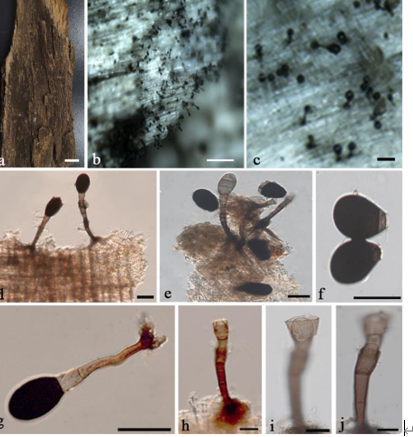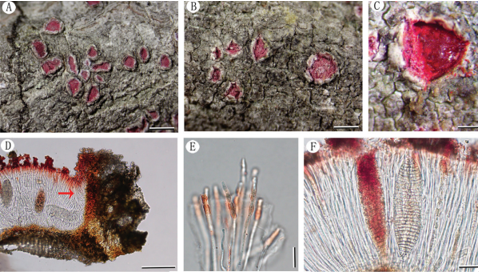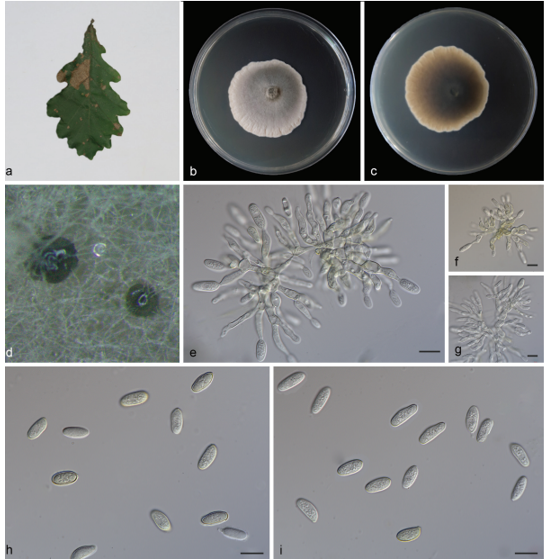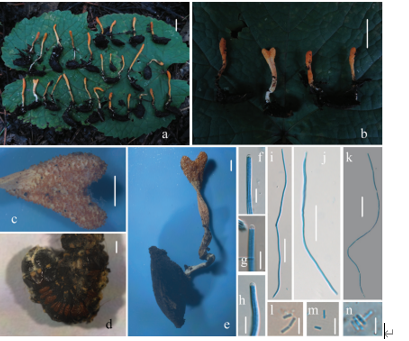Nemania feicuiensis Y.H. Pi & Q.R. Li, sp. nov. 2021
MycoBank No: 840089
Holotype: GMBC0059, ex-type living culture; KUN-HKAS 112698, isotype)
Morphological description
Sexual morph: Stromata effused-pulvinate, superficial, orbicular to ellipsoid or irregularly lobed, 5–27 mm long × 2.5–10 mm wide × 0.3–0.5 mm thick, surface blackish-grey, with inconspicuous perithecial outer mounds, crust weakly carbonaceous; interior black, stromatal tissue between the perithecia carbonaceous; mature stromata lacking KOH extractable pigments. Perithecia 0.3–0.55 mm diam. × 0.25–0.37 mm high, subglobose to depressedspherical. Ostioles higher than stromatal surface and with openings slightly papillate, black, conspicuous, without encircling disc. Asci 130–180 × 7–11.5 μm (av. = 145 × 9 μm, n = 30), 8-spored, unitunicate, cylindrical, long-stipitate, the spore-bearing parts 65–85 µm long, apically rounded with a J+ apical apparatus, 1–2.5 × 2–3 µm (av. = 1.8 × 2.4 µm, n = 30), long-cylindrical. Ascospores 9.5–13 × 4–7.5 μm (av. = 11 × 6 μm, n = 30), uniseriate, unicellular, ellipsoid or slightly inequilateral, with broadly rounded ends, smooth, brown to dark brown, with a conspicuous, straight, almost spore-length germ slit on the flattened side; lacking a sheath and appendage; perispore indehiscent in 10% KOH.
Asexual morph: Undetermined.
Cultures: . Colonies grow slowly on PDA at 25 °C for 2 weeks, with a diameter of 5 cm. Colonies are cotton white in colour, flocculent or velvety, slightly convex, circular, shallow edges, radial, white to light yellow on the reverse, light brown in the middle. Not sporulating on OA nor on PDA.
Habitat: , on dead wood
Distribution: l. China, Hainan Province, Wuzhishan City, Emerald Park (18°47'8.26"N, 109°31'5.34"E, altitude: 426 m),
GenBank Accession: its MW851879 ; rpb2 MW836064; tubulin MW836024; catin MW836045 .its MW851880; rpb2 MW836063; tubulin MW836023; catin MW836044.
Notes: The phylogenetic tree (Fig. 1) shows that N. feicuiensis and N. primolutea are closely related (100% ML, 1 BYPP). In morphology, N. feicuiensis differs from N. primolutea in that the latter has luteous stromatal surface and slightly smaller ascospores (10–13 × 4.5–5.5 μm) with narrowly-rounded ends (Ju et al. 2005). Furthermore, in the multi-gene phylogenetic analysis, N. feicuiensis appeared in a separate branch which is distinct from N. primolutea (Fig. 1). Nemania feicuiensis is similar to N. diffusa in stromatal anatomy and ascospores size, but differs by ascospores shape (broadly rounded ends vs. narrowly rounded ends) and the larger perithecia of N. diffusa (0.3–0.6 × 0.4–0.8 mm) (Ju and Rogers 2002
Reference: [1] Song, Y. J. , & Li, S. Q. . (2008). A taxonomic study of chinese nematogmus species (araneae, linyphiidae). Organisms, diversity, & evolution(4), 8.
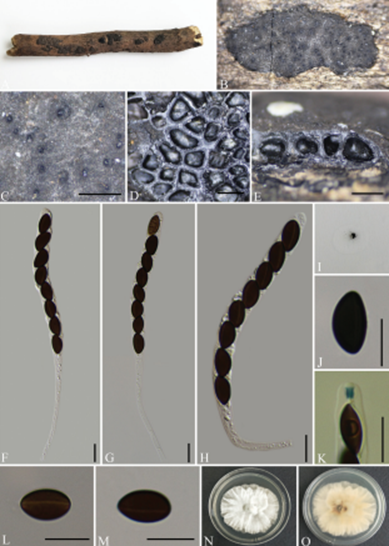
Nemania feicuiensis (GMB0059, holotype) A type material B, C stromata on the surface of host D transverse sections of stromata E longitudinal sections of stromata F–H asci with ascospores I pigments in 10% KOH J ascospore with indehiscent perispore in 10% KOH K ascus apical apparatus (stained in Melzer’s Reagent) L, M ascospores N, O colonies on PDA (N-upper, O-lower). Scale bars: 0.5 mm (C–E); 10 μm (F–H, J–M)


